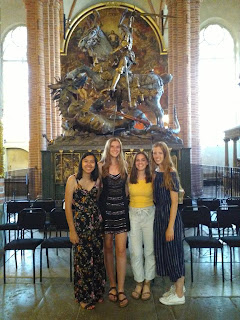1st stop Friday morning was Stockholm City Hall. Maria took us through the elaborate preparations for the Nobel banquet, the Hall's finest annual event. The great entrance hall is where all 1500 guests are seated and each is carefully allotted 50 cm (19.68"), otherwise they will not all fit. The prize-recipients and the Swedish royal family get 55 cm (21.65"). The royal family must loathe this evening. Yes, Nobel-prize winner and all but still, there must be limits to equality. Just so you know: if you are awarded a Nobel prize you get 14 tickets to invite friends and family; dancing is in the upstairs ballroom; save some energy for the royal dinner at the palace the following evening. Some tickets are available in a raffle ($300 for a raffle ticket; might be something for the Honors College to consider...)
Like the two other city halls this city hall also excels in myth and need for interpretation. Completed in 1923 Stockholm CH is a mishmash of Italian-inspired renaissance, Viking romanticism, and a hall of gold so out of this world in its selective depictions of Swedish history and quasi-mythological references that you wonder what the heck is going on. And the blue hall isn't blue.
Odd, in a sense, that these three cities/countries so proud of their egalitarian heritage celebrating democracy and creating three city halls dedicated to that virtue, produced such convoluted buildings in need of all kinds of massive academic pomp and circumstance in order to be understood. Come to think about it, shouldn't democracy be entirely transparent? So self-evidently obvious that even a Scandinavian caveman can understand it? With straight-forward buildings to boot? Some simple form of beauty and purpose? Instead, we have Oslo CH whose belated national romanticism (1950!) delivers a kaleidoscope of natural, urban and historical imagery fit for 1st year humanities students. Isn't democracy rather about bare walls and simple algorithms? Culture is for color. Likewise Copenhagen CH (1905) demands our suspension of disbelief (see day 10). All three are imposing, dramatic buildings, yes, definitely worth visits for their value as mental exercises. But do we need to work so hard for democracy?
The afternoon took us to the Swedish Royal Palace. Never seen so many postcards of a family so neatly presented. As mentioned previously: in Scandinavia we don't need the Disney corporation, we've got royal families. Anna, our guide, seemed near her breaking point probably for the umptiest time going through her selection of the shady deals and rapacious behaviors characterizing the Swedish monarchy, in the past at least. The building itself is an endless sideways stacking of seemingly random rooms sporting extravagant ornamentation, poor art, gaudy furniture what in conclusion leaves us with a strange sense of pumped up irrelevance. Does anyone today, visitor as well as local, walk away from such a tour with a renewed sense of comprehension and purpose?
After dinner we entered Storkyrkan, Stockholm's grand cathedral, for "Bach I," summer organ concert by Michael Waldenby. Since yours truly consider Johann Sebastian Bach (1685-1750) the greatest artist of all time, it was a pleasure introducing our students to his music albeit in the somewhat uncongenial soundscape of a cathedral organ. Their reviews after the 50 minute concert were politely supportive. Waldenby's final selection, Sinfonia D-dur, was a glorious celebration of upbeat human agency.
Friday morning on deck of af Chapman hostel.
At the Stockholm City Hall.
At the Royal Palace.
Josie, Madison, Olivia and Katelin at Storkyrkan for a Johan Sebastian Bach organ concert posing in front of St.George and the Dragon (Bernt Notke, 1489).
The group ready for Bach.








No comments:
Post a Comment